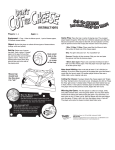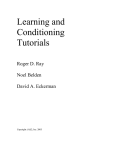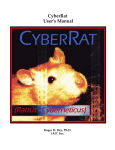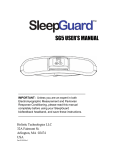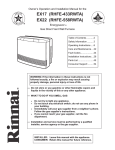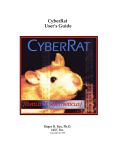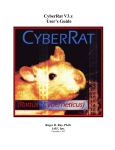Download APPENDIX TOPIC: Shaping a New Behavior Now that
Transcript
APPENDIX TOPIC: Shaping a New Behavior
Now that you have studied some of the principles of operant reinforcement, extinction, and stimulus control,
you are ready to put these principles to work. One good way to see the power of reinforcement in our lives is to
practice the use of a reinforcer to train a new behavior. Coaches do this all the time. For example, they give feedback
for skillful performance hoping this feedback will encourage the athlete to repeat that skill the next time the opportunity
arises. In the CyberRat shaping exercise you will act as a coach - for a rat. Not a rat you can actually hold in your
hand, but perhaps the next best thing, a simulation that will give you an experience very similar to what you would
have if you were to coach a real rat to press a real bar (the skilled performance) in a real operant chamber.
Have you have ever wanted to "talk to the animals?" In this exercise we hope you will see that reinforcement
provides one way to communicate with another individual - including an individual such as a laboratory rat. When you
give your simulated rat a drop of water as it presses the bar in an operant chamber, you will be playing one role in a
two-individual conversation that takes place between the rat and you. If your drop of water qualifies as a reinforcer for
the rat's behavior, soon the rat will be pressing, you will be giving "feedback," and your conversation will be going
back and forth like that of a good coach and a star athlete. As with good coaching, success will depend on your
timing and the correct selection of behavior to emphasize in your conversation. With practice, you and your rat will
both succeed.
This appendix was written to provide specific discussions of the processes involved as you begin to train new
behavior. We will use a specific example -- shaping CyberRat, the simulation based on a real laboratory rat, to press a
lever for water reinforcers. The process and principles of shaping, however, are more general and the discussion
should help you prepare for other examples of training as well. We suggest, however, that you should study your
CyberRat User's Manual both before you read this appendix and also that you keep a copy of the CyberRat User's
Manual nearby for cross reference. So, to learn how to shape, let's consider some specific tips, including:
Getting Ready for shaping.
Undertanding the Experimental Chamber.
Getting Your Subject Ready for Shaping.
Begin Shaping
Other Factors Involved in Shaping.
APPENDIX TOPIC: Getting ready for shaping.
Before you start shaping CyberRat or any other individual, you will need to make some selections concerning
the relevant experimental and subject variables involved in the process. In this section we will consider issues on
selecting your rat, which include considering both family and individual subject histories as well as manipulated
conditions such as deprivation.
First, choose your subject and know something about his or her family history. We have given you a bit of a
challenge by inviting you to shape the behavior of a laboratory rat. What do you know about such an individual? We
should emphasize that the simulated CyberRat you will get to know is actually made up of videos taken of a real
laboratory rat. Therefore CyberRat has mannerisms and behavioral patterns that are real - not just drawn from the
imagination or expectations of a cartoonist. You will work well with CyberRat if you are aware of what makes a real
laboratory rat "tick."
Laboratory rats are not as fearful of humans as are their wild counterparts. In fact, laboratory rats were
genetically selected many generations ago because they were tameable and, in fact, friendly when well treated. Today's
laboratory rats continue that tradition. Second, laboratory rats are generally hearty and healthy. They keep their
bodies quite clean by "grooming" their hair with their tongue and front paws. We think you will see your CyberRats
doing this.
They are sociable, and once acquainted quite playful with each other and with their caretakers. They explore
their environment and readily learn "what leads to what" (a skill we fully plan for you to observe!). They are capable
little creatures -- strong enough to push with a force greater than their weight (if they have the right place to stand),
jumping (with a vertical jump that is many times their height!) and climbing well and possessing excellent balance for
running along narrow ledges if given a chance.
They hear very well (detecting much higher pitches than humans, for example), are good at identifying odors of
interest to them (probably better than are we), and see well enough to navigate about a room (remember, in their normal
living conditions they are active at night and hence less "visual" than daytime animals such as humans). They tend to
poke their nose into small openings and sniff the air coming through and they seem to use their touch-sensitive
"whiskers" (called vibrissae) to inspect objects closely.
They balance well on their "haunches" (they often rear up on their hind legs to inspect objects above their head)
and they use their front paws to hold and manipulate things (like the bar we will offer them). Sometimes they use their
teeth to "explore" or even gnaw on things, holding and "shaking" objects as if to discover their properties, or holding
objects to "drag them away." One of the authors has, in fact, had his hand pulled into the cage by a rat with whom he
was quite friendly -- all done quite carefully, as though the rat sought the person's company.
You should know also, of course, that a rat's teeth are very effective incisors that can pierce and cause damage
when the situation calls for it (or when inept mistakes are made in handling the animal without due support, care, or
respect).
Second, know as much as possible about what your selected rat's specific individual history is. Is your rat
"experimentally naïve"? Researchers often divide the life of their rat participants into two stages -- before they became
subjects in scientific research, and after their career has begun It is doubtful that laboratory rats make this same
division. For them, they are learning all the time, always "building on" previous learning. Still, once your rat enters
the operant chamber for the first time, it will start accumulating experiences that will have much more specific
influence on its future behavior in that chamber, so in this case naïve simply means no prior experience in a chamber
like the one we will use for experimentation, and no history of being taught any behaviors like those we will attempt to
teach. Once it has learned to press the bar for water, for example, it will ALWAYS be easier to retrain this behavior,
even if years have gone by and many other things have been learned and unlearned.
For this reason, we encourage you to start by selecting your CyberRat animal quite specifically for what you
want your rat to accomplish in the operant chamber. As you will read below, any early experience in the chamber
provides some "habituation" to such chambers. Do you wish to observe that process? As rats learn about the water
delivery and its associated sounds (what we will call "magazine training" below) they will be much more trainable
when you seek to use water reinforcers to influence their behavior. Do you wish to carry out magazine training? Your
instructor may actually suggest that you select a rat that has already been magazine trained so you will be able to more
quickly shape bar pressing. But most will request that you start with an experimentally naïve animal so that you can
experience the ENTIRE process of training an animal, not simply one stage or dimension of that process. Even if you
start with a rat that has been magazine trained, however, please remember that successful training always "builds on"
prior experiences that are important in preparing the individual to learn "the next step." And, if you have time, we also
recommend that you start with an experimentally naïve rat so you can participate in developing this prior experience.
Finally, a word about prior water deprivation. One condition you will select as a parameter of one very
important experimental (independent) variable after you choose your rat is the level of water deprivation it will bring to
the experimental session. Whether a drop of water is or is not a reinforcer depends on the current level of water
deprivation, or to be more precise, the time since your animal last had water available for drinking. Within limits, of
course, the longer the deprivation the more effective the water is as a reinforcer. Rats generally drink each day, often
alternating between small drinks and small bites of food during their "meals". If a rat has access to water for 15
minutes in a day, however, it will generally maintain a good water balance unless the temperature is hot and very dry.
If you choose a rat that is 23 hours water deprived, then you will be able to use drops of water as an effective reinforcer
without doing any harm to your animal. This also allows one hour each day to conduct your experiment and to follow
with a period of free-access to water after the session. That is why CyberRat defaults to a setting of 23 hours water
deprivation.
At this point we may now turn our attention from understanding the rat we have selected to a better
understanding of the experimental chamber that also has been selected as the environment in which you will train your
animals.
APPENDIX TOPIC: Understand the experimental chamber.
The CyberRat simulation takes place inside a real "Skinner box" displayed via video (B.F.Skinner actually
preferred a more generic name for the simple space that he designed. He might want us to call it an "operant
conditioning chamber."). Usually such a chamber is a small cubic space, perhaps 1 foot on a side. This chamber also
contains several specific and unique elements that you need to understand, including the water delivery mechanism, or
magazine; the manipulandum; the stimulus lights; as well as some construction features that are relevant.
The water dipper, or magazine. As pictured below, the wall of our chamber has a square opening on its lower
left side that leads to a small enclosure. In some chambers this enclosure has a small hole on its floor and a small metal
cup can be raised through this hole to provide a drop of water to the rat. In other variations on water delivery an
electrical solenoid, or valve, is used to allow one drop of water to be transported from a bottle through a tube, with the
drop being deposited on the floor of the cup that fills the back of the opening. This is the form of delivery used in the
films upon which CyberRat is based, and it makes a practical difference. In the dipper delivery of water, only one drop
of water is ever present, even with repeated operations of the dipper. That is, the dipper cup only holds one drop and
submersing it while that drop is still there only replaces that drop with a new one. With the solenoid/valve delivery,
each delivery accumulates, thus giving the animal a potential "reserve" of several drops if several deliveries have been
made since the last visit to the water delivery area. Again, CyberRat uses this solenoid delivery, and thus drops of
water accumulate. In either case, the size of the drop can be experimentally altered, thereby changing the "amount of
reinfocement" given each time. As you read the CyberRat User's Manual you will find that you can change the size of
the water drop you deliver within CyberRat's experimental parameters screen. This is one of several details of the
chamber that is available for you to vary.
The manipulandum (or operandum). A rectangular bar, or lever, is mounted in the middle of this same wall, at
a height that allows the rat to place its paws on the top and press down. This "lever" or "bar" moves about 2 cm when
the rat presses down on it. Only a small force is required to press the bar, and pressing it causes a switch to close so the
equipment can record that a press has occurred. Because we will be training the rat to "manipulate" the bar and
because we will most often take pressing this bar as the operant behavior we will shape and study, this bar is sometimes
referred to as "the manipulandum" or as "the operandum."
Stimulus lights. Besides the water dipper and the bar, this same wall contains two stimulus lights. If you are
studying how a behavior comes to be emitted only in some situations and not in other siguations (e.g., light on rather
than light off, left-light vs right-light), you may turn these lights on and off as signals to the rat in the chamber.
The rest of the chamber. A plain metal wall is opposite the one with the bar and the other equipment. The
floor is composed of metal rods placed close enough together so that the rat is comfortable moving around but far
enough apart to allow urine and feces to fall through into the waiting pan of wood shavings below (for easy removal
and cleaning). The ceiling and the remaining two side walls of the chamber are made of clear Plexiglas plastic. The
chamber itself is placed within a smooth plastic "shell" that provides a quiet, evenly lighted spot for the chamber. A
fan in this shell keeps the air fresh inside.
Now, we have described this setting as though it is not very interesting, but you will notice that your rats
available in CyberRat will spend many minutes moving around inside the chamber, seeming to sniff at one thing
(especially at corners), nibbling on small details such as the bars on the floor or screws holding things together, rearing
up to the ceiling, etc. The rat will also spend some time grooming his/her fur and face, much like a cat does. You will
have many kinds of behavior to observe in even this simple operant conditioning chamber. As you train your rat to
press the lever, however, you will notice that these other possible activities become far less frequent. So let us now
move to considering how to best get your subject ready for shaping bar pressing.
APPENDIX TOPIC: Get your subject ready for shaping: Habituation
There are several elements of preparation that are important to accomplish properly if you wish to shape your
rat as quickly and efficiently as possible. These include habituating your subject to the novelty of being in a totally
foreign environment such as the operant chamber, magazine training the animal to respond to the sound of water
delivery, cautions against over-watering your rat in a single session, learning to observe all variations of behavior very
carefully, and learning to measure the operant (before conditioning) rate of the behavior you wish to modify or train. So
let's look at each element in more detail.
Habituation of exploration, of startle. When you first put your rat into the operant chamber, you will probably
see it move about, sniffing and touching all parts of the chamber. You might describe the rat as "a bit on edge, or very
alert." After a while, however, it will move around less and you might describe it as being "more comfortable." In this
quieter state, your water reinforcers will have a better chance to influence the rat's behavior. There is still a time,
however, when a novel noise will possibly evoke a jump or startle reaction. When you first operate the water dipper,
for example, you may notice this reaction -- more in real animals than the simulated rats in CyberRat's colony. Don't
worry. After this sound is paired a few times with the arrival of water, there will be no startle, just eager movement to
the water dipper. You should probably give the rat a few minutes to become less reactive to the environment (we could
describe this phase as "habituation" to the chamber - a kind of learning we might describe as "settling down"). In fact,
CyberRat allows you to run an entire "before-conditioning" habituation session where no water is available for bar
pressing or manual delivery by you. We recommend you conduct such a session for anywhere between 20-60 minutes
as an entire, separately identifiable "habituation" session so that measures of all the behaviors prior to shaping will
always be available for later comparisons as you conduct experiments to change these behaviors.
Thus, if you wish to measure operant level of all forms of behavior without the complications of presenting
drops of water or of having bar presses produce drops of water, you need to set the experimental condition (Schedule)
to "Habituation" before you begin your experimental session. Your CyberRat User's Manual will illustrate how to
accomplish this.
After running a prior habituation session, it is still a good practice to allow at least a few minutes of additional
habituation in the next session prior to operating the water dipper. To setup CyberRat to allow you to deliver water
reinforcers for training purposes, select Manual Reinforcement as your schedule. If you are going to attempt to shape
bar pressing you will also want the bar to deliver water reinforcers if it is pressed by your rat. To setup CyberRat
parameters to do this, as you select the Manual Reinforcement schedule, select the sub-menu item of "Bar ON". If you
intend to shape some behavior other than bar pressing, you would want Manual Reinforcement with Bar OFF.
Within 3-4 minutes of your new session your animal should be ready to learn to find the water if and when it is
presented. Begin by delivering one drop of water manually when the rat is a very short way away from the dipper or
has poked her nose into the reservoir (this will make the sound of delivery far less startling to the animal). But, after
the first 8-10 deliveries, you might start pressing your reinforcement button only as the rat is moving her head either
out of the reservoir or toward the water delivery area. The next section that explains the concept of magazine training
will tell you why this is a good idea.
APPENDIX TOPIC: Get your subject ready for shaping: Magazine training
Establishing a location where each reinforcer will be provided along with a sound as a signal that the reinforcer
has arrived (conditioned reinforcer) is an important step in allowing you to shape behavior elsewhere in the operant
chamber. An old-time meaning of the word "magazine" is "a reservoir or storage place, especially for provisions" (or
for gunpowder, but that's another story). "Magazine training," therefore, became the phrase used to describe teaching
the individual you are about to train as to where it can find the reinforcers you will use to accomplish your shaping.
Often the arrival of a reinforcer at that spot ("the magazine") produces a specific sound that signals its arrival (in our
case a click as the solenoid delivers a drop of water).
For a water-deprived individual, the association between these clicks and the arrival of water that they signal is
the basis for a variation of Pavlovian conditioning that establishes the click as a reinforcer -- a conditioned reinforcer.
This magazine training is an important prerequisite to successful shaping. We will emphasize below that reinforcers
should be given without delay when the rat emits a response that you are hoping to reinforce. You need to have the
"click" of the dipper be firmly associated with the rat finding water in the dipper, so that this sound will be as effective
a reinforcer as the water itself.
Beware of Satiation--not too many "free" drops of water, please. If you provide water too rapidly, the rat will
stop drinking temporarily. We say that the rat is satiated. Notice, however, that all we really know is that the rat will
not approach and drink from the reservoir. Water delivery no longer increases the frequency of approach to the
reservoir after its "click" (i.e., clicks or water no longer reinforce approach). On the other hand, if you separate the
deliveries of water by several seconds, the rat will continue to approach and drink after each click of the dipper. Of
course, after perhaps a hundred deliveries the rat will be satiated even if the rate of delivery is slow. Good shaping
requires that you achieve a balance between giving enough water deliveries to keep the rat engaged in the behavior you
are shaping, but not so many that deliveries lose their ability to reinforce behavior. With some practice you should
become expert at achieving this balance.
Once you have accomplished magazine training, of course, you have added another "reason" for the rat's
behaviors in the chamber - the rat might be "water seeking." In fact, the goal of shaping is to develop a specific way for
the rat to obtain water -- by pressing the bar. When a behavior consistently produces a consequence, that consequence
may positively reinforce the behavior -- that is, increase its future frequency. Another way to describe such an increase
is that you have provided another "reason" for emitting that behavior.
Now you may begin the REAL process of shaping some new behavior, such as pressing the bar. But the process
of shaping starts by observing the existing and ongoing behavior of the rat and then selecting certain of these actions by
consistently following them with a click and a drop of water. The actions you select should be those that move the
behavior closer to "pressing the bar for water" - the target behavior we are hoping to develop. This makes observation
skills critical in successful training and shaping.
APPENDIX TOPIC: Get your subject ready for shaping: Observe Behavior Carefully
We have discussed magazine training and the dangers of satiation. Now we are ready to get down to the work
of shaping the rat's behavior. It is time to watch carefully what the rat is "doing." We put that word in quotes, since it
is possible to think that all behaviors the rat emits are controlled in some way by the consequences of its behavior -- by
what the behavior accomplishes or produces. These consequences of the behavior (the "reasons" for the behavior) can
be viewed as natural reinforcers for that behavior. As you first observe your rat, you will not really know what these
reasons are. The rat moves around the chamber. It stops and sniffs in a corner. It moves toward the protruding bar
touching it with its nose. We ask what is the rat really "doing." Though we can loosely say that the rat appears to be
"exploring" its environment, it is always risky to offer reasons for a behavior until we have studied that behavior
thoroughly. As such, exploring may be more a description of the FORM of behavior than its purpose or outcome. It is
important to describe the behavior merely as movements and to keep an open mind regarding the specific "reasons."
Learning to describe behavior "neutrally" (without drawing conclusions regarding its reasons) is an important skill for
psychologists to develop. In clinical practice, for example, a psychologist should keep an open mind about the reasons
for a problem behavior until the repeating pattern of that behavior reveals why it keeps occurring (what it
"accomplishes." What the person is "doing."). There is a complete and highly sophisticated coding trainer built into
CyberRat that is accessed via the Multi-Behavior Analysis section of the upper-right menu. All behaviors in the
"coding system" offered there are clearly defined by the form of behaviors, not their functions or reasons for
occurrence. If you have significant difficulties in successfully shaping your rat, you may want to practice coding
behavior to acquire better observation skills as they relate to how rats behave (see the CyberRat Manual regarding
"coding"). From such descriptions and their quantification, you will be able to determine the "operant" (pretraining)
level of each form of behavior that is emitted in the operant chamber environment (see Unconditional Probabilities
graph in CyberRat's Multi-Behavior Analysis section).
Measure operant level. Does the rat press the lever before you begin to use your water reinforcers? If the rat is
already pressing the lever "for other reasons" it will be quite easy to reinforce these presses with water. Every coach
secretly hopes that his or her player already shows the skills needed to be great. Then all the coach need do is teach
when each skilled behavior is appropriate. When a skill is high before specific training, we say that it has a "high
operant level." So--does your rat already press the bar? Frequently? If so, you can wait until a bar press occurs "for
other reasons" and then deliver your water reinforcer. A specific process of shaping would not be required since the
target behavior could be reinforced directly.
However, we expect that your CyberRat will not have a high operant level of bar pressing unless you selected a
subject that has prior training on this behavior. Most laboratory rats will occasionally rest their paws on the bar as they
move about the chamber, or they will occasionally push at the bar with their nose. Usually these presses do not occur
often enough to encourage you to merely sit and wait for them. It is a good idea, however, to be aware of how often
such bar presses do occur and to take advantage of them when they do (that is, quickly deliver a reinforcer!!). CyberRat
simulations keep bar press operant levels extremely low so that animals don't just learn by "trial-and-error" on their
own, but rather require you to train each rat.
APPENDIX TOPIC: Begin shaping (if operant level is low)
OK, you have hopefully conducted a session using the Habituation schedule in CyberRat so you have a good
operant level measure for each class of behaviors emitted within the operant chamber. You also have started to conduct
one or more sessions where you have used magazine training techniques to establish a reliable "go-to-water" reaction
within a few seconds after delivering water (and its sounds associated with delivery). Now you are ready to reinforce
the closest available behavior that looks like it might be a component of bar pressing. Perhaps you have learned that
your rat does not press the bar very frequently "for other reasons." It has a low operant level for bar pressing. Instead,
it is doing other things - sniffing one place or another, moving from the back of the chamber to the front, etc. By using
principles of shaping, however, you can help move the behavior toward the target of bar pressing for water. Your first
step should be to reinforce the ongoing behavior of the rat that is the closest "approximation" to bar pressing.
Look at what your rat is doing. Since you have already accomplished magazine training, you may accidentally
have already increased the frequency of some behavior (such as approach to or perseverating at the water delivery
area). Watch your rat for a minute or two and decide which of its current behaviors is the one closest to bar pressing.
Is it removing its head from the water reservoir and turning toward the bar? Then wait for that behavior to occur and
immediately deliver a reinforcer. The timing of your delivery will be very important. A reinforcer affects most
strongly the behavior that occurs IMMEDIATELY before its delivery. If you delay your delivery, you will actually
reinforce the behavior that followed the one you were hoping to select! You need to be ready to deliver the reinforcer
quickly. Thus you will need to learn to predict what behavior the rat is actually emitting and will emit next. Is it
turning toward the bar? A reinforcer will increase the rat's tendency to do that again. Or is it actually about to return to
the back wall of the chamber? A reinforcer will increase that tendency and the process of shaping bar pressing may be
set back. Learning to accurately reinforce the behavior that is closest to the desired performance makes a good coach
successful. Shaping your rat to press the bar is an example of good coaching. It may take some practice, but we
encourage you to keep improving your shaping skills until your rat subjects in CyberRat show you are a successful
coach. To become this successful coach, there are four principles you should keep in mind that govern successful
shaping.
The first principle emphasizes the importance of timing. We have already warned that you should avoid
delaying the delivery of a reinforcer, because this will accidentally reinforce the behavior that occurs just before the
reinforcer is delivered.
The second principle is that by becoming familiar with the behavior of your rat in CyberRat, you should
become skilled at predicting an ongoing SEQUENCE of behaviors. One way to summarize this principle is that a good
shaper knows the individual being shaped extremely well and is ready to reinforce the behavior that is, in fact, closest
to the performance desired.
The third principle addresses the sequence of "approximations" that you choose in the shaping process. Shaping
is often referred to as the "Method of Successive Approximations." You will succeed as a trainer when you apply the
two principles above across a sequence of steps that moves the behavior ever closer to the desired target performance.
Planning such a sequence is the key to successful shaping when the ultimate performance is complex (e.g., teaching a
child to tie his or her shoes). Teaching CyberRat to press the bar for water actually involves teaching the rat to carry out
a series of steps involving approach to the bar (often from the location of the water reservoir), rising up and placing its
paws on the bar, and then pressing down on the bar. As you carry out shaping it is useful to think that you are training
this sequence.
A fourth principle: Move your behavioral criterion for reinforcer delivery at the "right pace" -- not too slow, and
not too fast. This principle addresses when you should shift from one step to the next in your sequence of
approximations. Suppose you have shaped the behavior of consistently turning toward the bar. The rat turns, and you
deliver your "click" with the water reinforcer. The rat then turns toward and collects its drop of water. But you want to
move to the "next step" in your series of successive approximations: "turning toward AND APPROACHING the bar."
When should you change your "rule" and wait until the rat not only turns toward the bar but actually moves toward it or
sniffs it? The next section provides some added information to help you make that decision.
APPENDIX TOPIC: "Not too slow"/ "Not too fast"
"Not too slow" -- As you continue reinforcing a specific behavior during the shaping process, that behavior has
a tendency to become more "fixed" - i.e., less variable from one occurrence to the next. The rat develops a consistent
and often simplified way of meeting this criterion. As the behavior becomes less variable, the variations that are still
"closer to the target behavior" become less frequent. As the behavior becomes stereotyped, it becomes more difficult to
shape the next step. Conclusion: don't wait too long. This part of principle four might be called "continued
reinforcement restricts behavior."
Another part of the fourth principle and another reason for not waiting too long is that sometimes a little
"extinction" can help generate new behavior that meets the requirements you have set for that "next step" in your
sequence. Just as continued reinforcement reduces variability, ceasing to reinforce a particular behavior increases
variability. Once you stop reinforcing a particular behavior (e.g., turning toward the bar), you can bet that the variety
of behaviors the rat emits will increase. After you stop reinforcing its turn toward the bar, for example, instead of
alternating between "turning toward the bar" and "turning back toward the water dipper" as it has been doing, you may
find the rat turning in circles, turning and rearing, turning and moving forward -- a variety of patterns of behavior.
Some of these behavioral sequences, in fact, may be different from any you have seen before. Remember that the
procedure of stopping the reinforcement of a behavior is called "extinction." This part of principle four might be called
"extinction at first promotes new behavior."
"Not too fast" -- But, just as you should not move your criterion too slowly (in order to avoid stereotypy and to
gain the benefits of a little "extinction"), you should also continue to reinforce behavior at each step of your sequence
long enough that the effects of your reinforcers produce an orderly change in the frequency of behavior you are now
reinforcing. That is, don't change criteria too quickly. So the last part of principle four is that you should see the
change in behavior become somewhat predictable before you shift to the next step.
We have now completed the description of principles that we think will help you shape your rats in CyberRat to
press the bar for water. The next section, however, lists three additional factors that might be added to these principles
of response shaping when you take your newly acquired talents and apply them to other types of behavioral change -behavior that can be prompted, that can be brought under discriminative control, and that can be developed to persist
even when reinforcement is intermittent. Prompting is not a part of CyberRat, but discriminative control and
intermittent reinforcement are.
APPENDIX TOPIC: Other Factors Involved in Creating New Behavior: Prompting
Sometimes the target behavior you wish to reinforce during shaping can actually be evoked or guided. We have
described how you can carefully reinforce successive approximations to a target behavior in order to create a new
behavior that had not previously been observed (e.g., a rat pressing a bar). Let's think now about how we might speed
up such a process. Could we speed it up, for example, if we found a way to directly evoke a bar press? If we could get
a rat to press the bar for "another reason," and then we gave a drop of water for each of these evoked bar presses,
perhaps the drops of water would act as reinforcers to strengthen the bar pressing. Then we would not need to carefully
select each successive approximation. That might work, though we would then need to remove this "other reason" if
we hoped to have the bar pressing continue for the water reinforcers alone. Would this approach work? Well, the
answer is "Maybe."
Consider an example in order to see the issues. Suppose, for example, you smeared a little peanut butter on the
bar and then put the rat in the chamber. Suppose further that your rat quickly approached and nibbled at this peanut
butter and, in the process of nibbling, pressed the bar. Suppose further that you followed this bar press with a drop of
water, which the rat drank. Will that drop of water reinforce bar pressing (i.e., increase the frequency of bar pressing)?
Perhaps yes, perhaps no. For this "short cut" to work to strengthen bar pressing, several things would need to be
true. First, the nibbling would need to produce bar presses several times so that the drop of water could have its
reinforcing effect. Second, the variety of bar presses would need to fit well with the kind of pressing you have as a
target behavior. Since what the rat is doing is nibbling, the bar presses that occur will probably be due to movements
made by its head rather than its paws. Will reinforcing head-presses also reinforce other kinds of bar presses? Third,
the water reinforcer would have to "compete" effectively with the peanut butter reinforcer for control of the ongoing
behavior around the bar (nibbling, pressing, etc.). That is, if the peanut butter is a very strong reinforcer and the water
a very weak reinforcer, we would probably not see much control by the water reinforcer. Fourth, the behavior of bar
pressing would need to continue even after the peanut butter had been consumed. When the peanut butter is present, it
undoubtedly has a strong smell and changes how the bar looks.
As you remember from your prior reading and as we will emphasize below, a reinforcer changes behavior "in a
specific context." When the peanut butter is gone (consumed), that may change the situation enough that the prior
reinforcers don't apply to behavior emitted in the presence of a bar-without-peanut butter. So, can you reinforce bar
presses that are evoked by nibbling at peanut butter? For these four reasons, our answer is "maybe." Try it on a real
animal (CyberRat doesn't "do" peanut butter or anything similar), but don't be surprised if you need to fall back to
shaping successive approximations. One of the more effective prompting techniques often seen in home dog training is
the use of a reinforcer (such as a bit of food) as a prompt, say to evoke a "sit up" by holding the reinforcer above the
dog's head, thus evoking a sniffing and reaching or lifting of the body to approximate a "sit up." Eventually that
reinforcer needs to be faded as the prompt or the animal won't situp without first seeing it.
Of course, when we want a human to perform a new behavior, we often model the performance and then ask
them to imitate what we did. Even small children have a strong tendency to imitate what they see. We can say, for
example, "Here's how a good golf swing looks (demonstrate a good swing)... Now you do it." And, the listener
probably will produce some kind of golf swing. This is a little like putting peanut butter on the bar in order to get the
rat to "give it a try." Your modeling has produced a swing.
For this to be a good first step in creating a new golfer, however, the same four kinds of worries list above apply
here as well. For your coaching to effectively improve their golf swing, your modeling and requests must continue to
promote attempted swings, these swings must be like the kinds of swings the person would make "on their own" when
you are no longer providing the model, the outcomes of their swings will need to provide strong enough reinforcers for
the control to switch from your encouragement to "playing golf," and the behavioral change produced by these swings
will need to persist even after you are no longer present. The "lesson of the peanut butter" might be, then, that just
prompting or evoking a behavior will not be enough. For a prompted behavior to continue without the prompt, you will
need to work to gradually shift control from the prompt to the stimuli and outcomes you hope will eventually be the
context and the reasons for the behavior.
APPENDIX TOPIC: Other Factors Involved in Creating New Behavior: Discrimination
Remember that reinforcement occurs in a context and its effect is limited to this context (discriminative control,
attention). We emphasized above that reinforcement changes behavior "in a situation" or "in a context." If you change
the situation (context) you may no longer see the effects of prior reinforcers that were given in the prior situation
(context). Said another way, the effects of reinforcement generalize only to some situations. So, if you have shaped a
skill in one context (say the safe environment of a psychologist's office), you may well have to gradually change the
situation, reinforcing the behavior in each of these different situations, until finally the behavior occurs in the situation
you are hoping to influence (e.g., giving the speech in front of a live audience).
Now, this control by context (which we will now call "discrimination" as you learned to do in the text) is often
an important part of what you are teaching. You may be teaching the individual, for example, to choose the correct one
of two alternatives such as in answering a True/False or a multiple choice question. Or you may be training them to
respond quickly when a danger light is illuminated. In many cases, the new performance we want to train involves
both learning what to do (behavior) and when to do it (discrimination training). Is there a way that the principles of
"successive approximations" may be used for such discrimination training? Our answer is a firm "Yes." We have given
a couple examples below.
The "Easy to Hard effect" provides one example of this teaching of generalization. Suppose you wanted to
teach an individual to perform a difficult listening task, for example, to understand native speakers conversing in a
language with which the individual was not familiar. Rather than starting by exposing the individual to this difficult
task, you might start by having the individual speakers speak slowly and use only standard "textbook" expressions.
Once the individual is able to understand this simplified conversation, you could gradually shift toward understanding
normal conversation of native speakers. The basic rule is, training a difficult discrimination is easier if the individual
can already carry out a simpler, related discrimination. Now, we include this example of the benefit of slowing down a
language when a person is learning to listen, even though we expect the example will generate some controversy.
Language instructors often emphasize the dangers of "slowing down" speech (slowing speech down changes it) and
they encourage their students to listen to normal-paced speech. Well, they are correct. We would agree that students
must push themselves to achieve understanding of the normal-paced speech, but we suggest that early in language
learning it is important to have exposure to easier material, with a gradual shift toward the normal pace and complex
phrases of native speech.
Transfer from control by one (easier) dimension to a different (less controlling) dimension by fading out the
first dimension. The example above involved transfer from an easy discrimination to a more difficult discrimination,
but both discriminations were drawn from the same "dimension," that is, the same kind of judgment (e. g. recognition
of slower to recognition of faster speech). Sometimes it is useful to establish an easy discrimination and then gradually
shift to a harder discrimination even though the easy and the hard discrimination each require control by different
"dimensions" of the situation. An example might be teaching a person who is developmentally delayed to distinguish
between different coins, say nickels, dimes, and quarters. Suppose you wish to teach this individual to pick the highervalue coin from each possible pair that is presented. We would suggest that you start by highlighting the correct
choice, perhaps by placing that coin on a white piece of paper while the incorrect coin is placed on a dark paper. It will
be easy to teach the person to choose the coin on the light paper over the one on the dark paper. As the training
continues, however, you could gradually change the brightness of the papers to make the brightness discrimination
more difficult. At some point, control may transfer from the brightness of the paper on which the coin is placed to
properties of the coins themselves.
A variation on this transfer procedure is possible if you place the coins on surfaces that can be back-illuminated
with various intensities of light. Start, as above, with the light turned on behind the surface with the correct coin and
dark behind the surface with the incorrect coin. After the individual learns to choose the brighter side, instead of
varying the brightness of the surfaces to produce a shift to properties of the coins, instead, delay turning on the light for
a brief period after the coins are shown. Gradually increase this delay. At first the person will wait until the light is
turned on and will then make their choice. But, this period before the light is illuminated is, as you can imagine, a
perfect time for the individual to study the coins, seeking to anticipate which one will be the lighted coin (correct). As
they come under control of the properties of the coins in this prediction, they may well make an early selection during
the pre-light period. By reinforcing correct "early" choices you will strengthen control by properties of the coins,
thereby shifting from lighting to coin characteristics.
APPENDIX TOPIC
Other Factors Involved in Creating New Behavior: Intermittent Reinforcement
Intermittent reinforcement increases persistence (perseveration) by reinforcing different variations of behavior.
There is still one more dimension to explore for the idea of "successive approximations" in training new behavior.
Often we want to train persistent behavior. "When the going gets tough, the tough get going," says the football coach.
That is, "if at first you don't succeed, then try, try again." How do we encourage such persistence? In all our examples
above, we encouraged the use of consistent, immediate reinforcer delivery in order to efficiently train a new behavior.
But, consistently reinforced behavior (often called "continuously reinforced behavior," or CRF) is not very persistent.
When the Soda Machine stops giving you a soda when you put in your money, you don't usually try, try again. That
would be "throwing good money after bad." But, life, the bard might say, is not a soda machine. If she doesn't say
"Yes" to your first request to go out for coffee, perhaps she WILL say yes to your second, third... Persistence might
even pay off.
Now, how might we train such persistence? Once a behavior is established (reinforced) you can shift from CRF
to using intermittent reinforcement. But it is important to do so in relatively small successive stages. Persistence is
demonstrated when a behavior continues to be emitted while it is only occasionally reinforced. You can generate
persistent behavior by gradually shifting from CRF to intermittent reinforcement.
We will give an example that hopefully will improve your skills as a parent when and if those skills are needed.
We suppose you too have been annoyed by standing in a grocery store check-out line behind a child who keeps
pleading with their parent to get them some candy. This asking for candy can be very persistent, can't it? The parent at
first says "No" and continues to say "No" but the child escalates by making the requests louder and more insistent until
the parent finally gives in.
Think about it. Intermittent reinforcement. And, notice the escalation? Doesn't that fit with our description
above of the effect of extinction on behavior? When you stop reinforcing a behavior that has previously been
reinforced (here, requesting candy) you will often find that the forcefulness and variety of the behavior increases
(technically called response induction). On a football field that may be the desired result. In a grocery store check out
line, we suffer from it. But, in either case, the persistence and forcefulness follow from a history of intermittent
reinforcement. Now, experiment with this phenomenon using CyberRat, but be aware that the rules of "not-to-fast"
apply to leaning out how dense the delivery of reinforcers are just as they apply to shaping new behaviors through
successive approximations. That is, there is a successive approximation to more and more intermittent schedules to be
considered, lest you extinguish the behavior before it becomes more persistent. (This extinction during schedule
transitions is sometimes referred to as "ratio strain").














